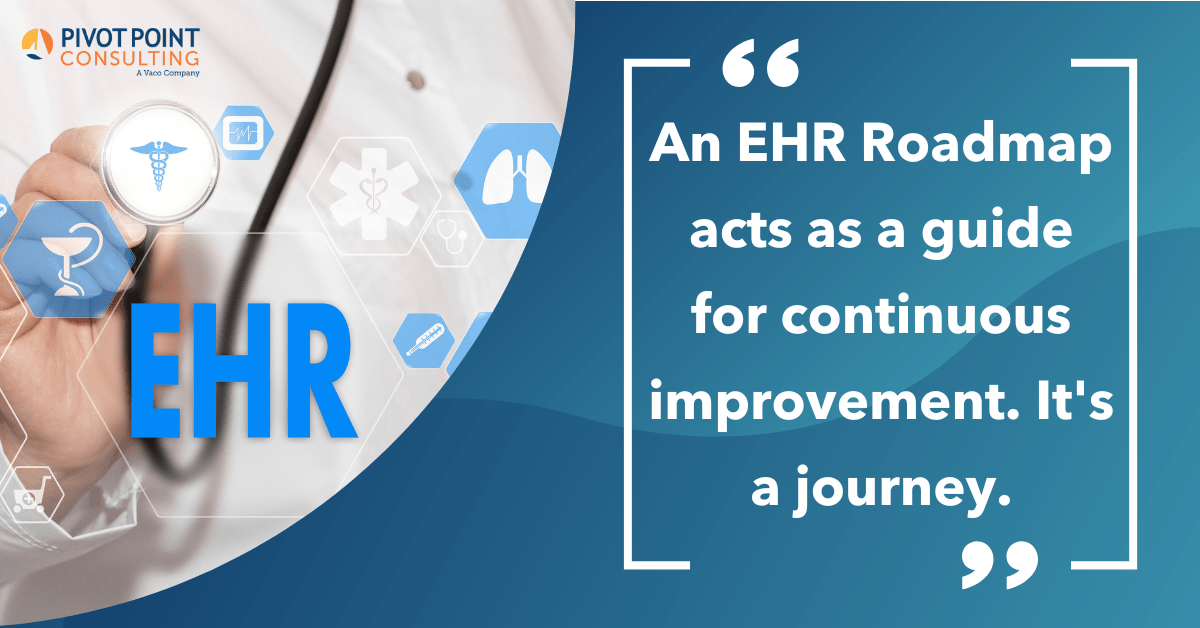What is an EHR Roadmap?
It’s no surprise that healthcare software updates require planning to ensure preparation of the entire organization. With frequent upgrades and competing priorities, however, organizations are struggling to keep up (or catch up) with capabilities and features. Many organizations have created EHR Roadmaps as a strategy to keep their organizations on track. Doing so also ensures the organization is progressing towards optimal use of its EHR software.
An EHR Roadmap isn’t a single project with static start and end dates, but a guide for your organization’s continuous improvement journey. The document is reassessed regularly to incorporate changing priorities as your organization identifies additional areas of improvement and the EHR vendor releases new functionality. As CMS updates reporting regulations or a worldwide pandemic hits, your roadmap and implementation team must be agile enough to pivot and prioritize the most pressing issues to align with your organization’s current focus. A roadmap that doesn’t reflect the organization’s current goals and interests will quickly lose momentum and leadership buy in. This is why a roadmap should contain a mix of both quick wins and long-term initiatives. Quick wins prove efficacy and instill confidence in the implementation team and stakeholders. Long-term initiatives often yield greater improvements but require substantial effort and can pause when other priorities arise.
To get you started on your journey, we’ve created the video below outlining the 12 steps of an EHR roadmap.
EHR Roadmap Tools
Appropriate tools to assist with successful design and implementation of an EHR Roadmap include:
- Project Charter: A high level document that outlines the purpose, goals and stakeholders of a project.
- Timeline: A visual representation of the planned schedule for a project, typically shown as a chronological list of events and their deadlines.
- Gantt chart: An effective tool for visualizing the relationships between tasks, sequence of deliverables and the resources needed.
- Kanban cards: A system used for visualizing work and limiting work-in-progress during a development project.
- SIPOC diagram: A high-level process map that stands for Suppliers, Inputs, Process, Outputs and Customers. It is used to visualize the components of a process and their interconnections.
- Ishikawa diagram: Also known as a fishbone diagram or cause-and-effect diagram, is a visual tool used to identify and analyze the potential causes of a particular problem or quality defect.
- Project plan: A comprehensive document that outlines the approach, resources and goals for a project.
- Flowchart: A visual representation of the steps and activities involved in a project. It shows the sequence of tasks and decisions and the flow of information and resources.
- Ticket management system for tracking work: A software tool used to manage and track requests, issues and tasks in an organized and efficient manner.
Why Is an EHR Roadmap Important?
The two main drivers across all healthcare organizations are improving patient outcomes and ensuring financial stability. Therefore, creating an EHR Roadmap aligns with both of those missions. By taking advantage of your EHR’s latest features, you can promote better patient care and maximize the ROI of the costly EHR investment. Enhanced reporting functionality, predictive risk scores and improved documentation for example, all equate to providing staff with the best tools available to protect patients and succeed in offering a higher standard of care.
Who Should Be Involved?
A key player or potential owner of the EHR Roadmap is an EHR Project Manager. (for organizations using Epic, this would be the certified Cogito Project Manager) This individual is intimately familiar with EHR functionality as well as the intricacies of project management. Between available functionality, previously identified opportunities for improvement and future goals, the EHR project manager will collaborate with organizational leadership to discuss priorities and establish recommendations on the order and timeline of work. Strong leadership support is imperative and should include the CIO, IT leaders, physician leaders, and nursing leaders in both inpatient and outpatient roles. The team’s combined workflow and business knowledge determines initiative prioritization and each member is responsible for cascading process updates to their respective areas.
How Can I Get Started?
A good first step is to identify pain points in your organization and review available EHR functionality. Complete a gap analysis to determine which pieces of available functionality might solve for certain pain points. Also, call out functionality that has been implemented but continues to be associated with a pain point. Those pieces of functionality likely require adjustment or further education to be effective.
Don’t hesitate to reach out for help if you or others at your organization are interested, but not familiar, with creating and implementing EHR Roadmaps. As with all initiatives, calculate your plan and execution before beginning. Otherwise, resources will be wasted, and organization will be headed in the wrong direction.
Looking for extra support? Our team of EHR experts have a proven track record of success.


